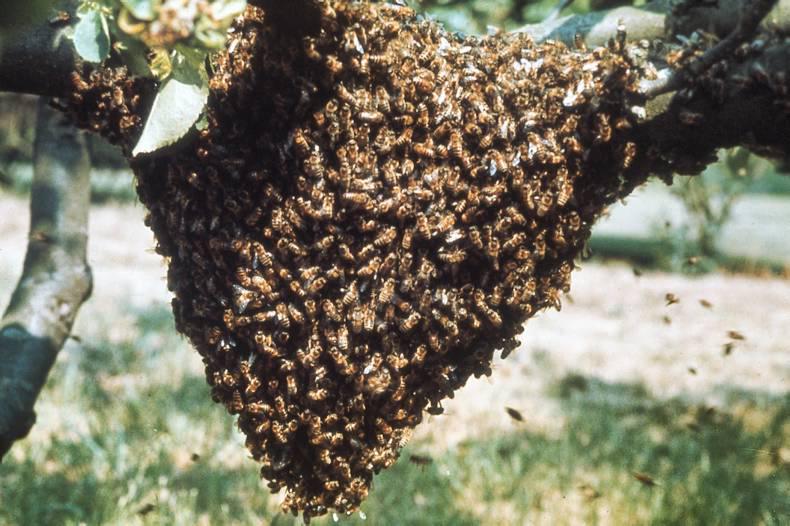The regular checks on our beehives are almost finished. From May onwards, the colonies were producing queen-cells. These are used to produce new queens.
Once the first queen cell in the hive is sealed over, the reigning queen flies off with most of the “forager bees”, that is those which are currently working on gathering nectar, pollen and propolis. These same bees would have spent the first three weeks of their lives in the hive doing all the cleaning, feeding and guard duties and are known as house bees. Then the next and last three weeks of their lives are spent collecting nectar, pollen, water and some propolis, hence the term forager bees. These are the ones which leave the hive with the queen in what is known as a swarm.
When a swarm has left the hive, there is no workforce left to gather any nectar for honey production. Only as those house bees mature and eventually become foragers, can normality return to nectar collection.
Any sealed brood remaining in the swarmed hive will soon hatch, as will any sealed queen cells. As the queen-cell or cells, which gave rise to the loss of the swarm with the queen, hatch, other smaller swarms may emerge. These are known as castes. Eventually there will be a settling down with no further castes. A new queen will hatch, mate and head up the colony.
So, now one can appreciate the necessity to make regular checks on hives for any queen-cells which are being prepared. Once found, the beekeeper must take action to avoid losing the bee workforce that’s so badly needed to gather the nectar for a honey crop.
During regular checks on the brood frames in the hive, the beekeeper will note if eggs are present. The presence of eggs indicates the queen is present or at least was within the past three days. Each frame of brood is thoroughly checked for queen-cells, which could lead to swarming. Often, the first indication of swarming preparations is a queen cup, which is a small, round, surface-mounted cell, built on the face of the brood comb. These cups may be dull inside, indicating that they have not been polished with propolis. A polished cell is one which the queen will lay an egg in. Once this egg hatches to a larva, bees will feed it with royal jelly so that it will then become a queen bee. On finding such a cell with a fed larva, alarm bells go off with the beekeeper. The beekeeper must now take immediate action to prevent swarming or risk losing the bees.
There are many ways of dealing with a hive which has prepared for swarming. Creating an artificial swarm is one such mechanism. This is done by moving the hive a few feet to one side and replacing it with a new hive prepared with frames fitted with wax sheets. The queen is taken from her hive and put into this new hive, usually done by taking the frame on which she is found and putting it into the new one. Any honey supers from the moved hive are put on top of the new hive containing the queen. The foraging bees will leave the moved hive and go into the new on, since this is their home location. They will carry on gathering nectar and the queen will lay up the new waxed frames.
The old moved hive will eventually have a new queen hatched and will settle down, but with little chance of producing honey until the following year.
As the beekeepers busy season of swarm control comes to a close, they will no doubt breathe a sigh of relief when the urge of nature to reproduce is satisfied.






 This is a subscriber-only article
This is a subscriber-only article





SHARING OPTIONS: